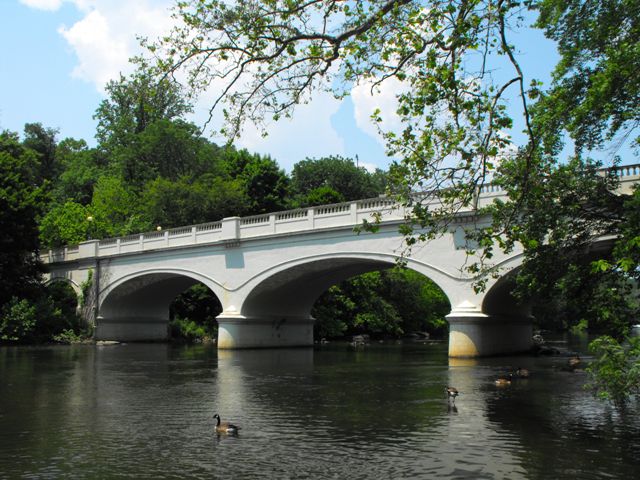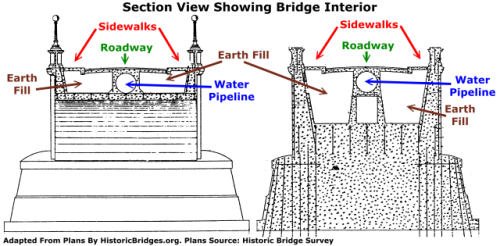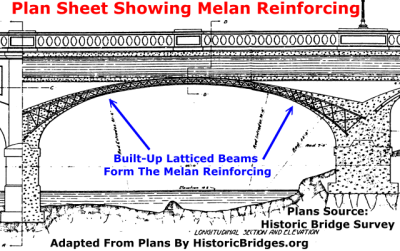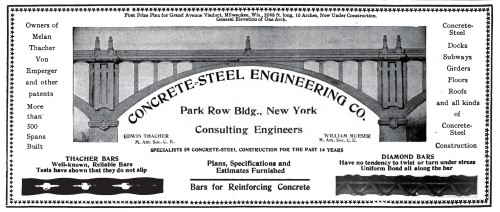We Recommend:
Bach Steel - Experts at historic truss bridge restoration.
Van Buren Street Bridge

Primary Photographer(s): Nathan Holth and Rick McOmber
Bridge Documented: May 30, 2010
Wilmington: New Castle County, Delaware: United States
1906 By Builder/Contractor: Unknown and Engineer/Design: Concrete-Steel Engineering Company of New York, New York
1998
64.0 Feet (19.5 Meters)
353.7 Feet (107.8 Meters)
24 Feet (7.32 Meters)
8 Main Span(s)
1698 000

View Information About HSR Ratings
Bridge Documentation
View Archived National Bridge Inventory Report - Has Additional Details and Evaluation
View All Historic Bridge Bridge Inventory Sheets For This Bridge
View The National Register Nomination For Brandywine Park Historic District, Which This Bridge Contributes To
View The Section 106 Documentation For The Reconstruction of This Bridge
This bridge is an early surviving example of a concrete arch bridge, and is the oldest known example in Delaware. The bridge is also an extremely rare example of an arch bridge with Melan type reinforcing. Melan arch bridges have built-up and/or rolled beams inside for the primary reinforcing in this way they are somewhat like concrete encased steel arch bridges. This particular bridge is extremely unusual and unique because the bridge was built not only to carry a roadway, but also to carry a large water main pipeline. An innovative method was designed for this bridge where the 48 inch pipeline was actually placed inside the bridge underneath the deck where earthen fill is traditionally placed on a closed spandrel arch. There was also earth fill inside this bridge, located in voids on either side of the centrally positioned pipeline. This solution allowed the bridge to fulfill two functions at once. This bridge was designed with significant architectural treatment (influenced by the City Beautiful movement) making the bridge truly attractive in appearance.
This bridge is a contributing structure to the Brandywine Park Historic District.
The unique design of the bridge was partly its downfall. The pipeline eventually deteriorated, and began to leak, which caused the bridge itself to in turn deteriorate more rapidly. In response to this problem, a large reconstruction project was undertaken that precariously rests on a fine line between bridge preservation and bridge replacement. From an engineering standpoint, this bridge is no longer an arch bridge. Modern pre-stressed concrete beams concealed within the bridge carry the load of the bridge today. Only the substructure of the bridge functions as part of the structure today. The arch portions of the bridge were left in place to maintain the historic appearance of the bridge. The spandrel wall of the bridge was apparently in very bad shape so a large portion of it was removed and replaced, with the original architectural details faithfully replicated on an new material placed. In contrast, the arch rings appear to be largely original and show less signs of alteration. As part of the project to install a new superstructure inside the historic bridge, the entire deck and railing system was replaced. The new railings have a balustrade design at the top and a solid wall on the lower potion, making them a lot taller than the traditionally designed balustrade railings that were originally on the bridge. The new railings appear to represent the greatest deviation from the original appearance of the bridge. The new railings look very unusual when viewed from on the bridge because they are so tall. It is not clear why such tall railings were used. There are shorter, more historically correct railings that have been deployed effectively in other concrete arch rehabilitation projects in other states.
The reconstruction project for this bridge certainly does not represent the most desirable preservation outcome because large amounts of original bridge material were replaced and the bridge no longer functions as an arch bridge, but at the same time, there is still a fair amount of original bridge material remaining as well, and a significant effort was made to replicate the original appearance of most of the bridge, and the load-bearing beams are carefully concealed within the structure. This method of concealing a new bridge inside the historic bridge is often done with stone arch bridges, and has been done with other concrete arch bridges as well. It may not be the best outcome for preservationists, but does represent a creative and effective compromise solution which can be used when all other more preferable preservation methods have been determined to be not feasible. The bridge is certainly a good demonstration of the wide variety of possible alternatives to the complete demolition and replacement of a historic bridge.
Below: A 1908 advertisement for the engineer.
This bridge is tagged with the following special condition(s): Melan
![]()
Photo Galleries and Videos: Van Buren Street Bridge
Bridge Photo-Documentation
Original / Full Size PhotosA collection of overview and detail photos. This gallery offers photos in the highest available resolution and file size in a touch-friendly popup viewer.
Alternatively, Browse Without Using Viewer
![]()
Bridge Photo-Documentation
Mobile Optimized PhotosA collection of overview and detail photos. This gallery features data-friendly, fast-loading photos in a touch-friendly popup viewer.
Alternatively, Browse Without Using Viewer
![]()
Maps and Links: Van Buren Street Bridge
Coordinates (Latitude, Longitude):
Search For Additional Bridge Listings:
Bridgehunter.com: View listed bridges within 0.5 miles (0.8 kilometers) of this bridge.
Bridgehunter.com: View listed bridges within 10 miles (16 kilometers) of this bridge.
Additional Maps:
Google Streetview (If Available)
GeoHack (Additional Links and Coordinates)
Apple Maps (Via DuckDuckGo Search)
Apple Maps (Apple devices only)
Android: Open Location In Your Map or GPS App
Flickr Gallery (Find Nearby Photos)
Wikimedia Commons (Find Nearby Photos)
Directions Via Sygic For Android
Directions Via Sygic For iOS and Android Dolphin Browser
USGS National Map (United States Only)
Historical USGS Topo Maps (United States Only)
Historic Aerials (United States Only)
CalTopo Maps (United States Only)





